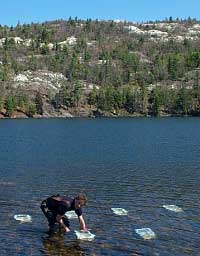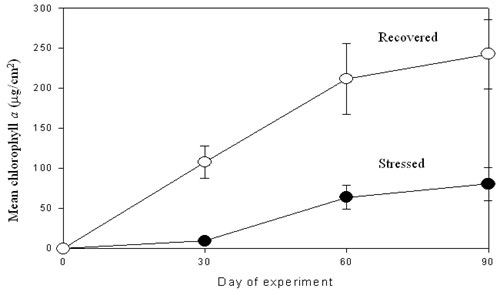
Introduction
Publications
Climate Change
Industrial Impacts
Agricultural Impacts
Urban Impacts
Biodiversity Loss
Definitions
Links
Site Map
|
 |
 Compensatory Species Dynamics and Grazing in Recovering Acidified Lakes:
Regulation of Biological Recovery Responses Compensatory Species Dynamics and Grazing in Recovering Acidified Lakes:
Regulation of Biological Recovery Responses
Research Objectives
- Determine if benthic, or lake bottom, grazing pressure and selectivity differ between acidified and recovered lakes.
- Determine whether grazer or algal communities show a greater capacity for
functional compensation in recovering acidified lakes. Functional compensation occurs when one species replaces another species but performs the same ecological functions.
Kristy hypothesizes that a compensatory shift from numerous small consumers in acidified lakes to fewer large consumers in chemically recovered lakes maintains overall grazing pressure, but changes its selectivity, such that the two consumer communities will have different effects on algal community composition.

This theory was experimentally examined in Killarney Park, Ontario, a region of boreal lakes that are showing recovery from anthropogenic acidification. The research is applicable to boreal lakes throughout Canada. A series of containers called mesocosms, as shown in the picture, were used to exclude different size categories of grazers such as invertebrates, tadpoles, and minnows from periphyton, which are microscopic plants and animals, including algae, that cling to underwater surfaces. Three acidified and three chemically recovered lakes were used. Kristy is testing for the impact of grazers on algal community biomass and species composition. Stable isotope analyses have been performed on consumers and periphyton to establish benthic food web structure (δ15N) and to quantify the primary carbon source (δ13C) of the major consumers in each study lake.
Does grazing pressure differ between stressed and recovered ecosystems?
Grazer impacts on periphyton were assessed at the community and species-levels over a 90 day period. The community-level results show that the development of periphyton was greater in recovering lakes. This was inferred through chlorophyll a testing, which is a surrogate measure of algal biomass. Grazing pressure, however, could not be detected as a factor affecting this development in either stressed or recovered systems.
 |
| The development of periphyton, inferred through Chlorophyl a |
Page 1 Page 2 Page 3
Back to Biodiversity Page
|  |








